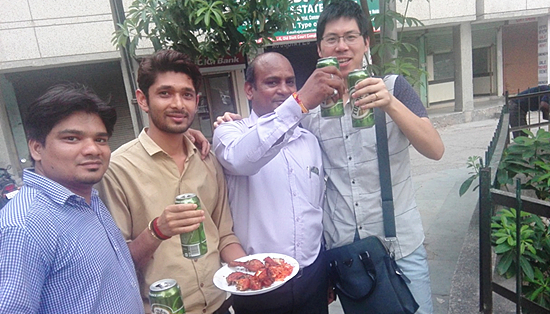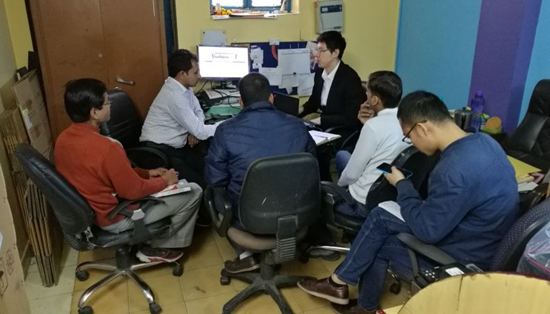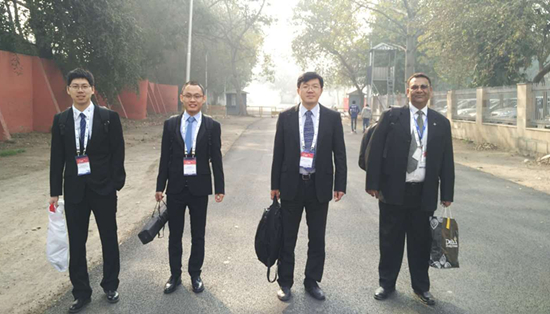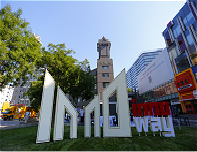Huahuan Electronics engineers in Suburban Bangalore, India
"If banks' ATMs are connected to your gadgets, then we don't have to go a long way to the city to withdraw money?" asked Chandru, a villager from suburban Bangalore, while looking at the protocol converter device being installed.
"Yes, our device can connect to ATMs in suburban areas, and money is withdrawn from them just the same as in the urban areas," said Zhou Lianhong, director at Beijing Huahuan Electronics Co., Ltd. He was in charge of the installation of the devices.
"Does my computer get access to the Internet if connected to this interface?" asked Aditya, an engineer in the rural area. He recently had bought his first-ever computer and thought only urban areas could have Internet access.
Despite India's fast economic growth in recent years, telecommunication businesses are mainly concentrated in the cities. In the rural areas, which are home to 70 percent of the country's population, communication services are largely absent. Ethernet private line services in rural areas have not many users and slow service, a thorny issue for both local carriers and government.

A technician from Huahuan Electronics and his Indian partners cheer the successful testing of devices in February, 2017.
"We hope to introduce a manufacturer offering high-quality products at competitive prices, which will be our EoPDH service provider and help Airtel maintain a leading position in India's ISP market," said business director of Airtel, India's No 1 carrier.
Despite the hot climate and intermittent power outages in India, Huahuan Electronics undertook the job, and achieved preliminary connection of networks only a week after Airtel put forward its requirements. Chinese engineers and local partners embraced one another in excitement the moment the signal showed a stable connection. The Indian company gave the Chinese partner thumbs-up for its fast response and decided to deepen cooperation with it.

Technicians from Huahuan Electronics and their Indian counterparts hold a discussion in May 2016.
Collaboration boosted rapport and friendship between Huahuan Electronics' technicians and their Indian partners. During India's Independence Day holiday, the Indian partners invited Huahuan staff members to a celebration party, where unique Indian food was offered and a drama about Hanuman, the undefeated demon fighting the Hindu monkey god, was staged.

Chinese and Indian technicians on their way to a testing site in February 2017.
"In China, we also have a Monkey King called Sun Wukong," said Zhou. "He came to India on a pilgrimage for Buddhist scriptures."
An Indian engineer responded, "We're now learning experiences and technologies from you in the hope of growing together with you."
The director of Airtel's network planning department said, "We didn't expect the Chinese company to take actions so swiftly. It significantly boosted the efficiency of network laying. Thank you!"
"Your equipment has helped us expand our service coverage and is very helpful to our rural business," said Airtel's regional manager. "An increasing number of rural townships are in need of EPL services, but mobile networks are expensive and subject to limited access speeds. EPLs provide customers with smoother telecommunication services and also reduce costs by at least 20 percent."
Connecting India's rural areas to the information highway is part of China's Belt and Road initiative and requires excellent technology. Moreover, it requires Chinese technicians to make tremendous effort and exercise enormous patience to overcome food and climate-related difficulties. On the ancient Silk Road more than 1,000 years ago, China traded silk and tea for Indian aromatics. Today, the two nations with the world's largest populations connect with each other through technological collaboration, and use their wisdom to revitalize their ancient civilizations.

 Facebook
Facebook WeiXin
WeiXin CONTACT US
CONTACT US










 Tsinghua Holdings works hard for better ecological environment
Tsinghua Holdings works hard for better ecological environment